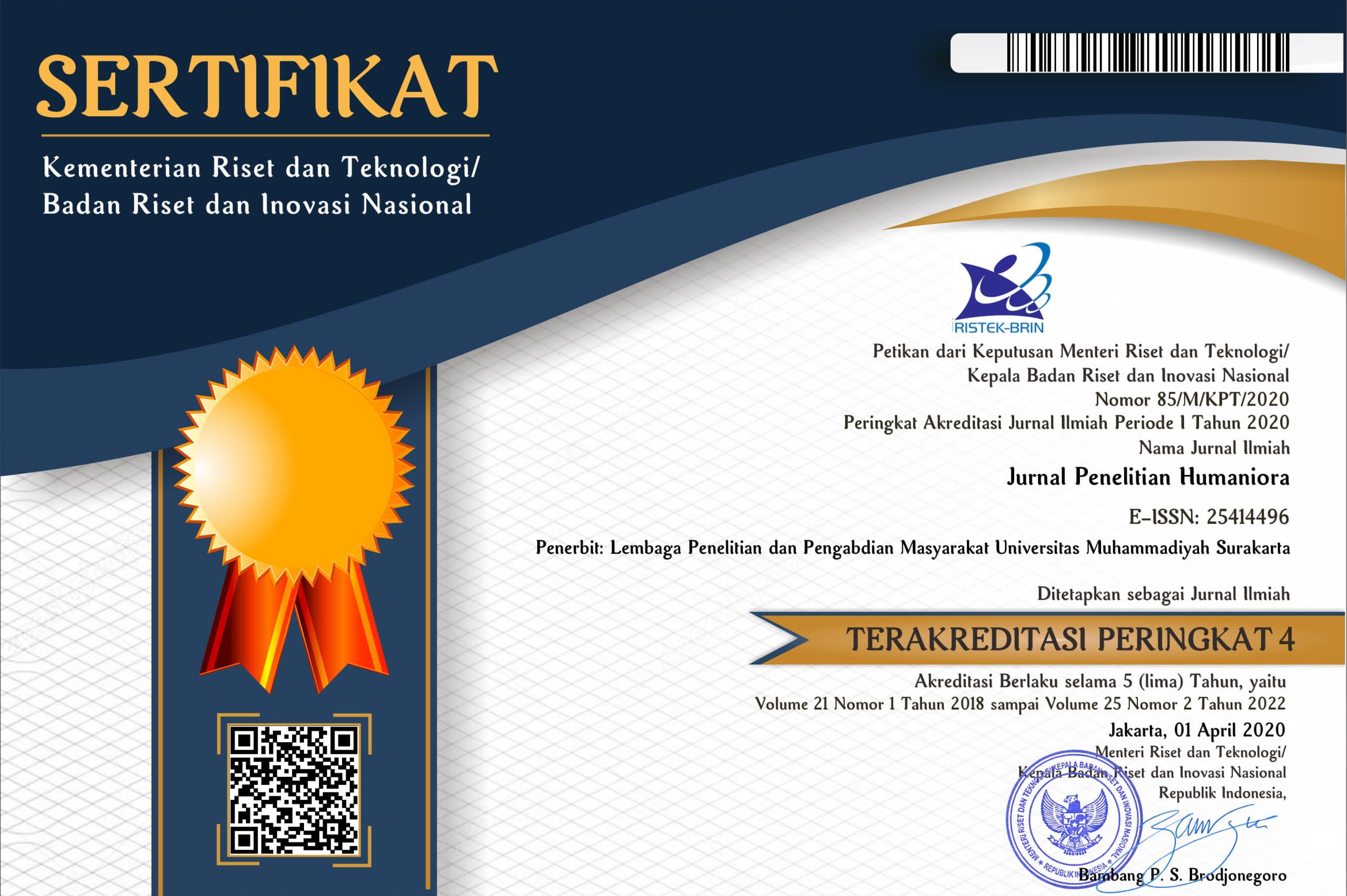PERMEABILITY OF INTERLANGUAGE SYSTEM: A CASE STUDY OF STUDENTS LEARNING ENGLISH AS A FOREIGN LANGUAGE AT SMP MUHAMMADIYAH 5 SURAKARTA
Lestari Kelik Maryana(1*)(1)
(*) Corresponding Author
Abstract
of the influence in students’ IL system, and (3) to describe the influence frequency of students’ IL system. The type of this research is qualitative research. The data of this research are erroneous sentences found in the students’ compositions. The method of collecting data is elicitation and document analysis. The writer uses descriptive analysis by Celce Marcia and a modified framework of Error Analysis by Shridar a technique for analyzing data. The results indicate that (1) the permeability is found at
the level of morphology and syntax, (2) the source of the influence is students’ mother tongue (Indonesian) and target language (English), (3) the influence frequency of the mother tongue to students’ interlanguage system is 48% and of the target language
to the students’ interlanguage system is 52%. The conclusion is that the learners’ interlanguage is open to to influence from the outside and influence from the inside language system. It progressively approaches the target language as a result of
learners’ attempt on constructing a new linguistic system.
Full Text:
PDFReferences
Adjemian, C. 1976. “On the Nature of Interlanguage System.” Language Learning. 26: 297320.
Caneday, Renae L. 2001. Interlanguge Coda Production of Hmong Second Language Students of English, University of North Dakota: Masters Thesis.
Corder, S. Pit. 1977. “The Significance of Learners’ Errors.” In Jack C. Richards (Ed.) 1997. 19-30
Corder, S. Pit. 1982. Error Analysis and Interlanguage. London: Oxford University Press.
Corder, S. Pit. 1978. “Error Analysis,” in J.P.B. Allen and Pit S. Corder (Eds) 1978:116-155.
Dulay, Heidi; Marina Burt and Stephen Karshen. 1982. Language Two. New York: Oxford University Press.
Ellis, Rod. Second Language Aquisition. 1997. New York: Oxford University Press.
Fauziati, Endang. 1999. Interlanguage Errors in English Found in the Textbooks for Junior High School Studens in Surakarta. Thesis. Jakarta: Program Pasca Sarjana: Universitas Katolik Indonesia Atma Jaya.
Fauziati, Endang. 2008. Reading on Applied Linguistics. Surakarta: Era Pustaka Utama.
Hobson, Carol B. 1999. “Morphological Development in the Interlanguage of English Learners of Xhosa.” Tesis. Afrika Selatan: Linguistik, Rhodes University.
James, Carl. 1998. Errors in Language Learning and Use: Exploring Error Analysis. London: Longman.
Nemser, William. 1977. “Approximative System of Foreign Language Learners.” In Jack C. Richards (Ed.) 1977: 53-63.
Saville-Troike, Muriel. 2006. Introducing Second Language Acquisition. Cambridge: C.U.P.
Selinker, Larry. 1977.”Interlanguage.” In Jack C. Richards (Ed.) Error Analysis: Perspectives on Second Language Acquisition. London: Longman.
Selinker, Larry. 1988. Papers in Interlanguage. Occasional Papers No.44, Singapura: SEAMEO
Regional Language Center.
Sharwood Smith, Michael. 1994. Second Language Learning: Theoretical Foundation. London: Longman.
Shridar, N.S. 1980. “Contrastive Analysis, Error Analysis, and Interlanguage: Three Phases of One Goal.” In Kenneth Crofth (Ed.) Reading on English as Second Language. 91-119.
Siregar, Sarmedi A. 2004. “Analisis Antar Bahasa (Interlanguage) Pembelajaran Bahasa Inggris di Politeknik Negeri Medan dan Yanada English Center Medan Suatu Studi Kasus.” Tesis. Medan: Program Studi Linguistik, Universitas Sumatera Utara.
Srijono, Djoko. 2001. An Introductory Course of Linguistic. Surakarta: UMS Press.
Tarone, Elaine. 1983. “Some Thoughts of the Nation of Communication Strategy.” In Clause French and Gabriele Kasper (Eds.) 1983:61-74
Yip, Virginia.1995. Interlanguage and Learnbility from Chinese to English. Amsterdam: John Benjamin B.V.
Article Metrics
Abstract view(s): 857 time(s)PDF: 954 time(s)
Refbacks
- There are currently no refbacks.











